By Janet van Zoeren and Tim Martinson
The VitisGen and VitisGen2 projects represent major investments in understanding grapevine genetics – and particularly in identifying markers associated with desirable traits for use in ‘marker-assisted selection’. DNA markers identified by geneticists and breeders are now incorporated into several selections and mapping populations by grape breeding programs in California, Minnesota, New York, and Missouri.
We asked VitisGen2 breeders to provide photos and brief descriptions of a few of their selections and mapping populations and the traits they incorporate. Where appropriate, we have highlighted the verified presence of genes through the use of markers in blue.
USDA-ARS, Crop Diseases, Pests and Genetics Unit
San Joaquin Valley Agricultural Sciences Center
Parlier, CA
Craig Ledbetter, Research Geneticist
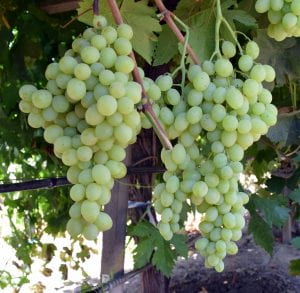 Y308-314-08 This is a mid-season table grape selection with powdery mildew resistance, which has the Ren4 gene. It was sufficiently attractive for trialing with other advanced table grape selections. It was the first PM resistant selection to be brought in for evaluation by the California Table Grape Commission, where there were positive comments from evaluators regarding the fruit attractiveness and productivity. It was finally removed from variety consideration because of excessive fruit acidity. We have continued to use this accession as a quality parent for Ren4 crosses.
Y308-314-08 This is a mid-season table grape selection with powdery mildew resistance, which has the Ren4 gene. It was sufficiently attractive for trialing with other advanced table grape selections. It was the first PM resistant selection to be brought in for evaluation by the California Table Grape Commission, where there were positive comments from evaluators regarding the fruit attractiveness and productivity. It was finally removed from variety consideration because of excessive fruit acidity. We have continued to use this accession as a quality parent for Ren4 crosses.
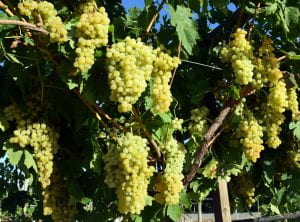
Y306-196-10 This natural dry-on-vine raisin selection has all the makings of a new raisin cultivar. The vine is extremely productive and berries begin drying down in early August. Dry product quality is very high and berries resist powdery mildew infection because of the carried Ren4 gene. The selection is currently under yield evaluation to examine its commercial potential.
 Color population It is difficult to identify new red-skinned table grape selections with high quality skin color, so a 300-vine population was created from red-skinned parents that differed greatly in the quality of skin color. The reason for creating this population is to identify a DNA marker that is linked to high quality red skin color. All fruiting vines are being phenotyped for skin color quality, and vine DNA profiles will be examined to identify any markers linked to high quality red skin color. Depicted in the photo are fruit clusters from two vines: a high quality red to the left of the trunk, and low quality red to the trunk’s right.
Color population It is difficult to identify new red-skinned table grape selections with high quality skin color, so a 300-vine population was created from red-skinned parents that differed greatly in the quality of skin color. The reason for creating this population is to identify a DNA marker that is linked to high quality red skin color. All fruiting vines are being phenotyped for skin color quality, and vine DNA profiles will be examined to identify any markers linked to high quality red skin color. Depicted in the photo are fruit clusters from two vines: a high quality red to the left of the trunk, and low quality red to the trunk’s right.
 Y511-151-12 This is the first red-skinned selection with powdery mildew resistance to be evaluated for fruit quality in advanced selection trials. Fruitful on both spurs and canes, the selection yielded between 950 to 1400 boxes per acre, depending on applied cultural treatments. Vitis cinerea (Ren2) is the source of this selection’s powdery mildew resistance. The round attractive fruit ripen in mid-September and produce a 7 gram berry with 21° Brix. Consumer evaluations have been positive, with flesh texture and sweetness being notable positive attributes.
Y511-151-12 This is the first red-skinned selection with powdery mildew resistance to be evaluated for fruit quality in advanced selection trials. Fruitful on both spurs and canes, the selection yielded between 950 to 1400 boxes per acre, depending on applied cultural treatments. Vitis cinerea (Ren2) is the source of this selection’s powdery mildew resistance. The round attractive fruit ripen in mid-September and produce a 7 gram berry with 21° Brix. Consumer evaluations have been positive, with flesh texture and sweetness being notable positive attributes.
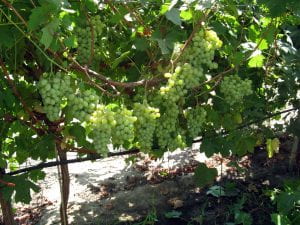 Y514-109-12 This late-season table grape selections owes its resistance to V. romanetii, the donor of Ren4. It is currently being evaluated for the possibility of release in collaborative trials with the California Table Grape Commission. The white-skinned selection has achieved 1076 boxes per acre in these trials, with clusters averaging 1.3 lb. on spur-pruned vines. Fruit of this selection are particularly clean, due in part to its vigorous canopy that protects developing berries from both sunburn and ambering. While this selection may or may not ever become a new cultivar, its genetics have already been used for several seasons to donate its unique combination of powdery mildew resistance and fruit quality traits to new seedlings.
Y514-109-12 This late-season table grape selections owes its resistance to V. romanetii, the donor of Ren4. It is currently being evaluated for the possibility of release in collaborative trials with the California Table Grape Commission. The white-skinned selection has achieved 1076 boxes per acre in these trials, with clusters averaging 1.3 lb. on spur-pruned vines. Fruit of this selection are particularly clean, due in part to its vigorous canopy that protects developing berries from both sunburn and ambering. While this selection may or may not ever become a new cultivar, its genetics have already been used for several seasons to donate its unique combination of powdery mildew resistance and fruit quality traits to new seedlings.
Cornell Grape Breeding and Genetics Program
Cornell AgriTech, Horticulture Section
Cornell School of Integrative Plant Science
Geneva, NY
Bruce Reisch, Professor
 NY12.0107.01 This white wine grape selection is derived from a complex cross made in 2012, and confirmed through VitisGen marker analyses to carry both Run1 (for powdery mildew resistance) and Rpv1 (for downy mildew resistance). This particular vine was planted in 2014 as a single vine seedling, propagated in 2017, and planted in a six-vine plot in 2018. Fruit were netted and harvested in September 2020, and we expect to evaluate the first wine sample next spring. The very long, moderately compact clusters bear fruit with mild flavors, and seem free of hybrid characteristics derived from North American species. One of its quality ancestors include ‘Muscat Hamburg’. It may have potential for high productivity.
NY12.0107.01 This white wine grape selection is derived from a complex cross made in 2012, and confirmed through VitisGen marker analyses to carry both Run1 (for powdery mildew resistance) and Rpv1 (for downy mildew resistance). This particular vine was planted in 2014 as a single vine seedling, propagated in 2017, and planted in a six-vine plot in 2018. Fruit were netted and harvested in September 2020, and we expect to evaluate the first wine sample next spring. The very long, moderately compact clusters bear fruit with mild flavors, and seem free of hybrid characteristics derived from North American species. One of its quality ancestors include ‘Muscat Hamburg’. It may have potential for high productivity.
 NY10.0927.02 Another white wine grape selection bearing attractive clusters of light red fruit. As with its ‘Aromella’ ancestor, this selection has some flowery, aromatic components in the fresh fruit, likely derived from its ‘Gewürztraminer’ background. The cross was made in 2010 and seedling vines were planted to a permanent vineyard in 2012. This selection was then propagated in 2017 and planted to a test site in 2018. Fruit were harvested this year for sensory analysis in 2021. According to VitisGen tests that were run on the seedling vines, this selection carries Run1 and Rpv1, as described above, but also carries Ren2 powdery mildew resistance from Vitis cinerea.
NY10.0927.02 Another white wine grape selection bearing attractive clusters of light red fruit. As with its ‘Aromella’ ancestor, this selection has some flowery, aromatic components in the fresh fruit, likely derived from its ‘Gewürztraminer’ background. The cross was made in 2010 and seedling vines were planted to a permanent vineyard in 2012. This selection was then propagated in 2017 and planted to a test site in 2018. Fruit were harvested this year for sensory analysis in 2021. According to VitisGen tests that were run on the seedling vines, this selection carries Run1 and Rpv1, as described above, but also carries Ren2 powdery mildew resistance from Vitis cinerea.
 NY15.0416.01 This blue grape selection was created expressly for the interest in a juice grape with high levels of powdery mildew and downy mildew resistance. Another goal of the cross was to have relatively early ripening compared to ‘Concord’. The juice grape parent was a very early ripening selection created in the 1950s by the Experiment Station breeding program. It was a hybrid of an early ripening blue labrusca grape with Concord. The other parent donated resistance genes (Run1 and Rpv1) to the cross, and possibly Ren3 as well. This cross was made in 2015 and vines were planted to a seedling vineyard in 2017. Fruit were first observed in 2019 and the vine has already been propagated. Small juice samples were made in 2020 from two harvest dates in September. The flavor of the fresh fruit is quite similar to ‘Concord’.
NY15.0416.01 This blue grape selection was created expressly for the interest in a juice grape with high levels of powdery mildew and downy mildew resistance. Another goal of the cross was to have relatively early ripening compared to ‘Concord’. The juice grape parent was a very early ripening selection created in the 1950s by the Experiment Station breeding program. It was a hybrid of an early ripening blue labrusca grape with Concord. The other parent donated resistance genes (Run1 and Rpv1) to the cross, and possibly Ren3 as well. This cross was made in 2015 and vines were planted to a seedling vineyard in 2017. Fruit were first observed in 2019 and the vine has already been propagated. Small juice samples were made in 2020 from two harvest dates in September. The flavor of the fresh fruit is quite similar to ‘Concord’.
 4427075 This is a new wine selection in the Cornell-Geneva grape breeding program. Marker assisted selection results indicated the presence of two genes for powdery mildew resistance (Run1 and Ren2), and one for downy mildew resistance (Rpv1). The cross was made in 2014, and though we have no wine results yet, the flavors of the fresh fruit reflect a lack of wild grape off-flavors, and presence of pleasing fruity flavors. Fruit ripen mid-season.
4427075 This is a new wine selection in the Cornell-Geneva grape breeding program. Marker assisted selection results indicated the presence of two genes for powdery mildew resistance (Run1 and Ren2), and one for downy mildew resistance (Rpv1). The cross was made in 2014, and though we have no wine results yet, the flavors of the fresh fruit reflect a lack of wild grape off-flavors, and presence of pleasing fruity flavors. Fruit ripen mid-season.

4427025 This red wine grape also come from a cross made in 2014, so wine hasn’t yet been tested. With large clusters that are not overly compact, the vine appears to have good yield potential. In 2019, the vine had nearly no black rot in a planting with a great deal of black rot. Resistance to powdery and downy mildews are also excellent; DNA results indicate the presence of Run1, Rpv1 and Ren2.
 4405008 During meetings with growers early in 2015, it was suggested that juice grapes with flavor profiles similar to current industry standards (Concord and Niagara) but harboring strong levels of disease resistance would be a desirable goal. So, in June 2015 and 2016, a number of crosses were made with this goal in mind. There were several outstanding examples among the seedlings that began fruiting in 2018 and 2019. Here is one such selection grown under fungicide-free conditions in 2019, with ripe fruit on September 19. This young vine comes from a cross made in 2016 and is precocious and productive. Time will tell if these will be worthy of release; we have yet to determine juice suitability (though they do taste great!), winter hardiness, and stability across years and sites. But several seedlings show promise.
4405008 During meetings with growers early in 2015, it was suggested that juice grapes with flavor profiles similar to current industry standards (Concord and Niagara) but harboring strong levels of disease resistance would be a desirable goal. So, in June 2015 and 2016, a number of crosses were made with this goal in mind. There were several outstanding examples among the seedlings that began fruiting in 2018 and 2019. Here is one such selection grown under fungicide-free conditions in 2019, with ripe fruit on September 19. This young vine comes from a cross made in 2016 and is precocious and productive. Time will tell if these will be worthy of release; we have yet to determine juice suitability (though they do taste great!), winter hardiness, and stability across years and sites. But several seedlings show promise.
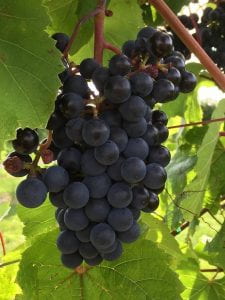 NY06.0514.06 This promising red wine grape selection, with excellent powdery and downy mildew resistance from the use of Run1, Rpv1 and Ren2, is already going out to trials with NE1720 University cooperators and others. Though the cross was made prior to the start of the VitisGen projects, this selection was tested for presence of resistance genes using VitisGen resources. The fruit have excellent resistance to bunch rot, and fruit and foliage have moderate resistance to black rot. The buds are moderately winter hardy, with expected temperature of 50% bud kill in mid-winter measured to be -15 °F. Wine descriptors are as follows: fruity with notes of blackberry, plum, cherry; slightly herbaceous, with green pepper noted; good body and medium tannin; also, some have detected chocolate notes.
NY06.0514.06 This promising red wine grape selection, with excellent powdery and downy mildew resistance from the use of Run1, Rpv1 and Ren2, is already going out to trials with NE1720 University cooperators and others. Though the cross was made prior to the start of the VitisGen projects, this selection was tested for presence of resistance genes using VitisGen resources. The fruit have excellent resistance to bunch rot, and fruit and foliage have moderate resistance to black rot. The buds are moderately winter hardy, with expected temperature of 50% bud kill in mid-winter measured to be -15 °F. Wine descriptors are as follows: fruity with notes of blackberry, plum, cherry; slightly herbaceous, with green pepper noted; good body and medium tannin; also, some have detected chocolate notes.
University of Minnesota Grape Breeding and Enology Program
Department of Horticultural Science
St Paul, MN
Matthew Clark, Assistant Professor
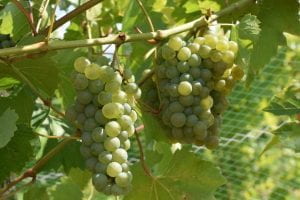 GE0012-01 This selection is from a population of La Crescent x Seyval blanc. This selection has relatively large berry size and large clusters (169.83 g/l), and at harvest has 24.2° Brix, 2.91 ph, 12.17 g total acidity. In the past we have harvested on 9/24/18. This vine has a low incidence of powdery mildew, which may be inherited from Seyval blanc (Ren3 resistance allele). There is downy mildew on the leaves, which is typical of its parent La Crescent. The clusters had no incidence of black rot, a common problem in the vineyard in 2019. The flavor and aroma profile includes honey, lemon, kiwi, pear, and gooseberry.
GE0012-01 This selection is from a population of La Crescent x Seyval blanc. This selection has relatively large berry size and large clusters (169.83 g/l), and at harvest has 24.2° Brix, 2.91 ph, 12.17 g total acidity. In the past we have harvested on 9/24/18. This vine has a low incidence of powdery mildew, which may be inherited from Seyval blanc (Ren3 resistance allele). There is downy mildew on the leaves, which is typical of its parent La Crescent. The clusters had no incidence of black rot, a common problem in the vineyard in 2019. The flavor and aroma profile includes honey, lemon, kiwi, pear, and gooseberry.
 GE9408-01 Descended from Vitis riparia, ‘Carmine’, ‘Mandan’, and Landot noir 4511, this selection is from a cross of MN1094 x Seyval blanc. As a descendant of ‘Seyval’, our marker tests indicated that it also carries the Ren3 resistance allele for powdery mildew. This grape produced a small (68.6 g), compact cluster but is interesting for its appeal in the wine, specifically the low titratable acidity (7.1 g/l) and moderate soluble solids (24.5 °Brix). The wine was described as cherry, smoke, leather, berry, and with some tannin.
GE9408-01 Descended from Vitis riparia, ‘Carmine’, ‘Mandan’, and Landot noir 4511, this selection is from a cross of MN1094 x Seyval blanc. As a descendant of ‘Seyval’, our marker tests indicated that it also carries the Ren3 resistance allele for powdery mildew. This grape produced a small (68.6 g), compact cluster but is interesting for its appeal in the wine, specifically the low titratable acidity (7.1 g/l) and moderate soluble solids (24.5 °Brix). The wine was described as cherry, smoke, leather, berry, and with some tannin.
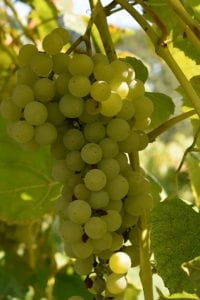 GE0733-01 This selection is a seedless table grape that is highly aromatic and has many tropical flavors. The parentage is unknown and will require DNA testing to confirm the possible parents. Most likely this selection is derived from Elmer Swenson’s breeding line and does carry the proper alleles at the SDI locus for seedlessness. The leaves of this selection have no incidence of powdery mildew. The yellow berries are 2.3 g each, and clusters are 92.33 g. Due to polar vortex in 2014 and 2019, this vine has not produced much fruit in USDA Zone 4. Primary clusters are large, but secondary buds or latent buds reliably produce smaller clusters. This is an earlier variety with harvest around the second week of September, 21.8 °Brix and total acidity of 6.69 g/l.
GE0733-01 This selection is a seedless table grape that is highly aromatic and has many tropical flavors. The parentage is unknown and will require DNA testing to confirm the possible parents. Most likely this selection is derived from Elmer Swenson’s breeding line and does carry the proper alleles at the SDI locus for seedlessness. The leaves of this selection have no incidence of powdery mildew. The yellow berries are 2.3 g each, and clusters are 92.33 g. Due to polar vortex in 2014 and 2019, this vine has not produced much fruit in USDA Zone 4. Primary clusters are large, but secondary buds or latent buds reliably produce smaller clusters. This is an earlier variety with harvest around the second week of September, 21.8 °Brix and total acidity of 6.69 g/l.
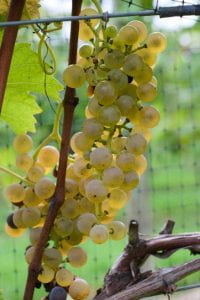
VB9276-01 Wine described with muscat with floral notes including lilac and tropical fruits like banana. This selection is a cross of VB 86-4 and Frontenac. Selected for white wine, this selection has relatively low titratable acidity compared to other cold hardy hybrids at 7.11 g/l. The berries are smaller like ‘Frontenac’ and the bunches are loose like that parent as well. This selection is susceptible to black rot and powdery mildew. It is marginally hardy in our Zone 4 conditions.
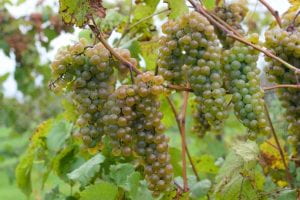 GE9913-01 This selection is an offspring of the above (VB9276-01) crossed with ‘La Crescent’. Unfortunately it demonstrates severe susceptibility of leaves to downy mildew. However, the fruit appear to be immune, which is the same in ‘La Crescent’. Despite having muscat ancestors, this selection is more neutral in its flavor profile, not demonstrating hybrid or muscat characteristics. This wine is described like Sauvignon blanc. It is grassy, green fruit, with aromas of peach and citrus. This selection is not suitable for Zone 4 conditions without additional winter protection. It may also benefit from a longer, warmer growing season further south.
GE9913-01 This selection is an offspring of the above (VB9276-01) crossed with ‘La Crescent’. Unfortunately it demonstrates severe susceptibility of leaves to downy mildew. However, the fruit appear to be immune, which is the same in ‘La Crescent’. Despite having muscat ancestors, this selection is more neutral in its flavor profile, not demonstrating hybrid or muscat characteristics. This wine is described like Sauvignon blanc. It is grassy, green fruit, with aromas of peach and citrus. This selection is not suitable for Zone 4 conditions without additional winter protection. It may also benefit from a longer, warmer growing season further south.
 Fine Mapping Family MN 1264 x MN 1246 We developed this population of nearly 1000 individuals in order to fine map important traits that were previously mapped in our GE1025 population (Teh et al. 2017, Clark et al. 2018). We are currently evaluating this population for resistance to powdery mildew, foliar phylloxera, and the presence of leaf trichomes. This planting was established in 2019 at the Horticultural Research Center and should produce its first fruit for evaluation in 2020. We hope to use this population to improve our understanding of fruit color, bunch architecture, flower sex, and fruit quality traits such as hybrid flavors.
Fine Mapping Family MN 1264 x MN 1246 We developed this population of nearly 1000 individuals in order to fine map important traits that were previously mapped in our GE1025 population (Teh et al. 2017, Clark et al. 2018). We are currently evaluating this population for resistance to powdery mildew, foliar phylloxera, and the presence of leaf trichomes. This planting was established in 2019 at the Horticultural Research Center and should produce its first fruit for evaluation in 2020. We hope to use this population to improve our understanding of fruit color, bunch architecture, flower sex, and fruit quality traits such as hybrid flavors.
